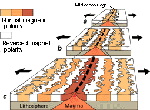 Many natural phenomena that occur on the Earth's surface due to processes occurring in the upper mantle of the Earth. The most interesting and significant are Continental Drift and Plate Tectonic. Continental drift is the movement of the Earth's continents relative to each other. The hypothesis that continents 'drift' was first put forward by Abraham Ortelius in 1596 and was fully developed by Alfred Wegener in 1912. However, it was not until the development of the theory of plate tectonics in the 1960s, that a sufficient geological explanation of that movement was understood. Plate tectonics describes the large scale motions of Earth's lithosphere. The theory encompasses the older concepts of continental drift, developed during the first half of the 20th century, and seafloor spreading, understood during the 1960s. The lateral movement of the plates is typically at speeds of 50—100 mm annually. Plate motions range up to a typical 10-40 mm/a (Mid-Atlantic Ridge; about as fast as fingernails grow), to about 160 mm/a (Nazca Plate; about as fast as hair grows). Some aspects of the Continental Drift and Plate Tectonics are considered below.
Many natural phenomena that occur on the Earth's surface due to processes occurring in the upper mantle of the Earth. The most interesting and significant are Continental Drift and Plate Tectonic. Continental drift is the movement of the Earth's continents relative to each other. The hypothesis that continents 'drift' was first put forward by Abraham Ortelius in 1596 and was fully developed by Alfred Wegener in 1912. However, it was not until the development of the theory of plate tectonics in the 1960s, that a sufficient geological explanation of that movement was understood. Plate tectonics describes the large scale motions of Earth's lithosphere. The theory encompasses the older concepts of continental drift, developed during the first half of the 20th century, and seafloor spreading, understood during the 1960s. The lateral movement of the plates is typically at speeds of 50—100 mm annually. Plate motions range up to a typical 10-40 mm/a (Mid-Atlantic Ridge; about as fast as fingernails grow), to about 160 mm/a (Nazca Plate; about as fast as hair grows). Some aspects of the Continental Drift and Plate Tectonics are considered below.
|

